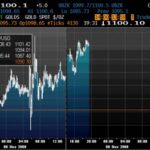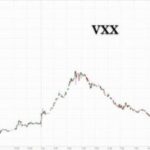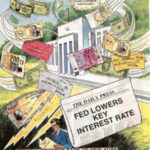Gennaio 28, 2010 EcoAnemia
Pillole dai mercati
Il fatto più importante della giornata di ieri è stato senza dubbio la rottura di 1.40 da parte dell’€/$.
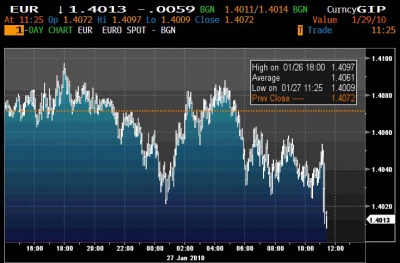
Solo temporanea al momento, tale da pensare che sia per ora solo un falso movimento :

Ma è interessante notare che ciò che sembrava fino a qualche settimana fa impossibile, ora è realtà.
Nel frattempo, sembra essere tornato di moda il flight to safety : il T-Bill ad 1 mese ha rendimento negativo, era dai tempi della bancarotta di Lehman che non si vedeva questo fatto :
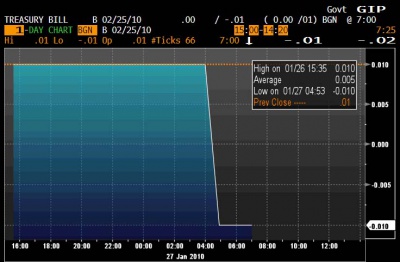
Una visione anche questa non molto ottimista per il futuro, così come il pessimo dato di ieri : New Home Sales -7.6% rispetto a Novembre, molto al di sotto delle attese .
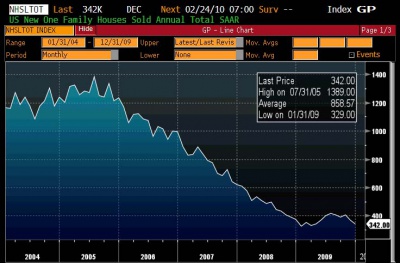
Double dip certo, ovviamente, ma è interessante – a riguardo – leggere ciò che ha scritto ieri Bloomberg commentando questo dato che definire pessimo è poco :
[…] Sales of new homes in the U.S. unexpectedly dropped in December, signaling a government tax credit may no longer be helping shore up demand.
Purchases declined 7.6 percent to an annual pace of 342,000, the fewest since March, the Commerce Department said today in Washington.
For all of 2009, sales dropped 23 percent to 374,000, the lowest level since records began in 1963.
Sales were projected to climb to a 366,000 annual pace from an originally reported 355,000 rate in November, according to the median estimate in a Bloomberg survey of 70 economists. Forecasts ranged from 340,000 to 399,000.
The government revised November’s reading to 370,000. […]
Fine degli “stimoli” statali, fine delle vendite di case nuove.
Dati pessimistici che sono in contrasto con gli ultimi forniti dal FMI, che ha appena alzato le stime sul PIL 2010, ma nel contempo abbassate quelle sul 2011.
Come dire , un colpo al cerchio ed uno alla botte :
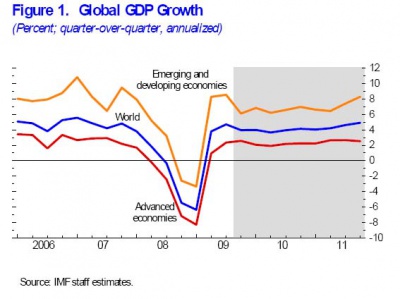
E nel dettaglio per i vari stati :
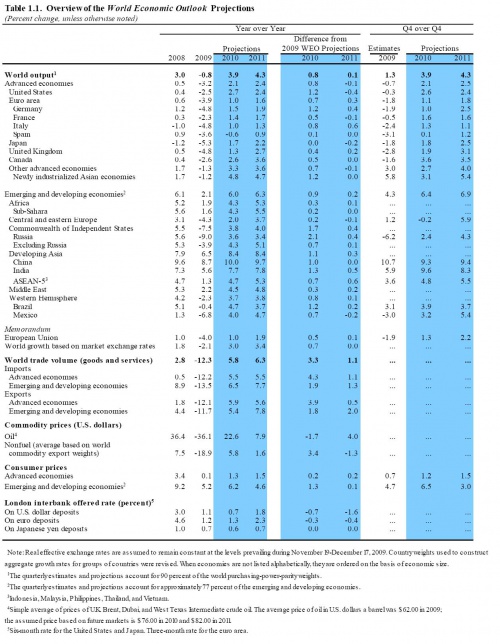
Ma qualcosa non torna, soprattutto perchè alcuni scenari appaiono assolutamente irrealizzabili :
[…] Regarding monetary policy, many central banks can afford to maintain low interest rates over the coming year, as underlying inflation is expected to remain low and unemployment high for some time.
At the same time, credible strategies for unwinding monetary policy support need to be prepared and communicated now to anchor expectations and dampen potential fears of inflation or renewed financial instability.
Countries that are already enjoying a relatively robust rebound of activity and credit will have to tighten monetary conditions earlier and faster than their counterparts elsewhere[…]
Già, tutto deve procedere perfettamente a gonfie vele, e soprattutto senza nessuna paura, nè dell’inflazione, nè della deflazione, come se proprio non esistessero.
Ed inoltre :
[…]Due to the still-fragile nature of the recovery, fiscal policies need to remain supportive of economic activity in the near term. The fiscal stimulus planned for 2010 should be fully implemented.[…]
[…]The sequencing of exit from accommodative monetary and fiscal policy should be guided by a variety of considerations, including whether: high fiscal deficits and debt are raising concerns about sustainability and sovereign risk—which is the primary consideration in many countries.
Low interest rates might be contributing to asset price bubbles; the exchange rate is under pressure to appreciate or depreciate as well as its position relative to medium-term fundamentals; and how quickly monetary or fiscal policy can be adjusted to changes in domestic demand.[….]
Già, costo del denaro mantenuto infinitamente basso tendente allo zero per un periodo di tempo indefinito.
Questa è una storia che non andrà certo a finire bene.
Ed infatti il rischio per gli stati sovrani continua ad aumentare, altro record per il CDS sulla Grecia a 370 :
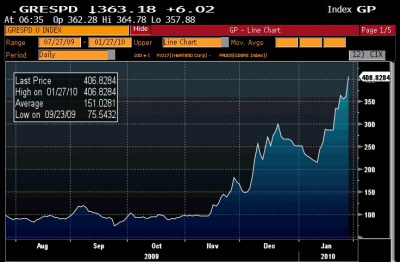
Sul fronte tecnico, da segnalare il rimbalzo dello Spoore, che dovrebbe estendersi nei prossimi giorni fino a 1105/1108, da cui dovrebbe partire un nuovo impulso ribassista (anche se il condizionale è d’obbligo, naturalmente) :
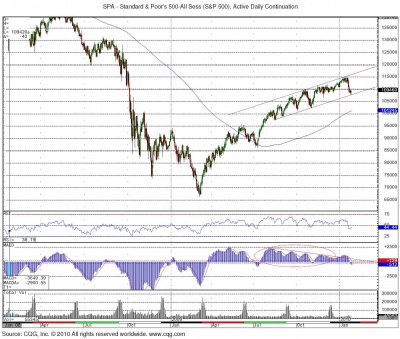
E’ per altro interessante notare come la liquidità stia rapidamente restringendosi, e questo fatto è visibile semplicemente vedendo che i rally hanno sempre un carattere piuttosto violento, ma con bassi volumi, mentre i sell-off hanno sempre alti volumi.
Interessante notare il commento proveniente dai floor traders del CME :
[…]Tuesday morning, about 10:00 a.m., the Dow had a sudden sharp 70 point swing.
It was over in a minute or two.Floor traders were astounded to notice that the 70 point reversal saw volume jump only 15 million shares.
That move, on such small volume, was stunning and indicates that liquidity is well below the norm.[…]
La Fed sta già restringendo la liquidità, non un buon segno per i bulls.
Ed anche il Copper, considerato il vero termometro della ripresa economica, ieri – nonostante il rally degli indici azionari dell’ultima ora – ha dimostrato ancora un’altra volta segni di debolezza, – 3.23% :
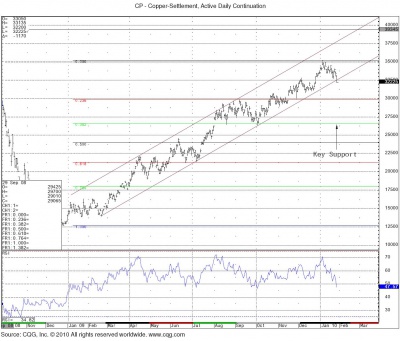
Mentre il Gold sta per esaurire il suo movimento correttivo :
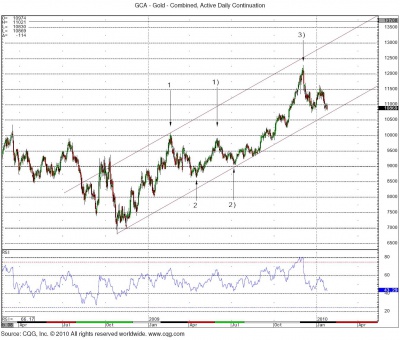
Bene, oggi altra giornata importante dal punto di vista delle trimestrali.



